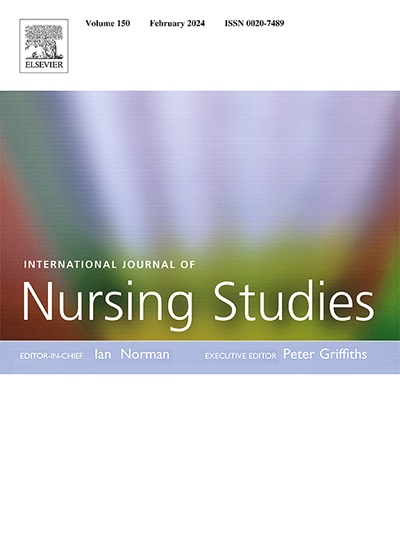Effectiveness of exercise-based interventions in preventing cancer therapy-related cardiac dysfunction in patients with breast cancer: A systematic review and network meta-analysis
IF 7.5
1区 医学
Q1 NURSING
引用次数: 0
Abstract
Background
Despite advances in cancer treatment that have improved survival rates among patients with breast cancer, they are at high risk of developing cancer therapy-related cardiac dysfunction, which typically manifests as heart failure. Although exercise improves cardiorespiratory fitness in these patients, its effectiveness in preventing cancer therapy-related cardiac dysfunction remains unclear.
Objective
To assess the effectiveness of exercise-based interventions using cardiac function parameters and to identify the optimal exercise modality for preventing cancer therapy-related cardiac dysfunction.
Design
A systematic review and network meta-analysis.
Methods
A comprehensive search was conducted across PubMed, Embase, Scopus, Web of Science, and the Cochrane Library databases, covering all records from their inception through August 6, 2024. Studies that used exercise-based interventions, either exercise alone or with other interventions, were included. Those with insufficient data for the primary and secondary outcomes were excluded. Quality appraisal was evaluated using the risk of bias tool (RoB-2). All statistical analyses were conducted using the meta (version 7.0–0) and gemtc (version 1.0–2) packages in R software (version 4.3.3). For continuous outcomes, pairwise and network meta-analysis were employed to estimate mean differences (MDs) and 95 % confidence intervals (CI). The Surface Under the Cumulative Ranking Curve (SUCRA) was employed to rank treatments. The study protocol has been registered on PROSPERO (ID: CRD42024501160).
Results
In total, 13 randomized controlled trials involving 1122 participants were included in the review. There was low-to-high risk of bias across thirteen studies. Compared to usual care, exercise-based interventions significantly improved left ventricular ejection fraction (MD, 1.68; 95 % CI, 0.59–2.77) and global longitudinal strain (MD, 1.40; 95 % CI, 0.59–2.21). Based on the ranking probabilities, combined aerobic and resistance exercise was the most efficacious method for improving left ventricular ejection fraction (four studies; SUCRA, 0.96), followed by exercise-based cardio-oncology rehabilitation (two studies; SUCRA, 0.45) and aerobic exercise (four studies; SUCRA, 0.42). In terms of improving global longitudinal strain, combined aerobic and resistance exercise also ranked highest (three studies; SUCRA, 0.88). However, exercise-based cardio-oncology rehabilitation (two studies; SUCRA, 0.47) and aerobic exercise (one study; SUCRA, 0.45) were less effective.
Conclusions
This network meta-analysis showed very low certainty for the prospective efficacy of exercise-based interventions, especially the combined aerobic and resistance exercise, in preventing cancer therapy-related cardiac dysfunction. Further rigorous studies are required to confirm the effectiveness of exercise-based interventions in preventing cancer therapy-related cardiac dysfunction among patients with breast cancer.
以运动为基础的干预措施预防乳腺癌患者癌症治疗相关心功能障碍的有效性:系统综述和网络荟萃分析
背景:尽管癌症治疗的进步提高了乳腺癌患者的生存率,但他们患癌症治疗相关心功能障碍的风险很高,这通常表现为心力衰竭。虽然运动可以改善这些患者的心肺功能,但其在预防癌症治疗相关心功能障碍方面的有效性尚不清楚。目的评价以心功能参数为基础的运动干预的有效性,并确定预防癌症治疗相关心功能障碍的最佳运动方式。设计系统评价和网络荟萃分析。方法对PubMed、Embase、Scopus、Web of Science和Cochrane Library数据库进行综合检索,涵盖从数据库建立到2024年8月6日的所有记录。包括使用运动干预的研究,无论是单独运动还是与其他干预相结合。排除了主要和次要结局数据不足的患者。采用风险偏倚工具(rob2)评价质量。所有统计分析均使用R软件(4.3.3版本)中的meta(7.0-0版本)和gemtc(1.0-2版本)软件包进行。对于连续结果,采用两两和网络荟萃分析来估计平均差异(MDs)和95%置信区间(CI)。采用累积排序曲线下曲面(SUCRA)对处理进行排序。该研究方案已在PROSPERO注册(ID: CRD42024501160)。结果共纳入13项随机对照试验,1122名受试者。13项研究的偏倚风险从低到高。与常规护理相比,运动干预显著改善左心室射血分数(MD, 1.68;95% CI, 0.59-2.77)和全局纵向应变(MD, 1.40;95% ci, 0.59-2.21)。基于排序概率,有氧和阻力联合运动是改善左心室射血分数最有效的方法(4项研究;SUCRA, 0.96),其次是基于运动的心脏肿瘤康复(两项研究;SUCRA, 0.45)和有氧运动(4项研究;SUCRA, 0.42)。在改善整体纵向应变方面,有氧与抗阻结合运动也排名最高(3项研究;SUCRA, 0.88)。然而,基于运动的心脏肿瘤康复(两项研究;SUCRA, 0.47)和有氧运动(一项研究;SUCRA, 0.45)效果较差。该网络荟萃分析显示,以运动为基础的干预措施,特别是有氧和阻力联合运动,在预防癌症治疗相关心功能障碍方面的前瞻性疗效的确定性非常低。需要进一步严格的研究来证实以运动为基础的干预措施在预防乳腺癌患者癌症治疗相关心功能障碍中的有效性。
本文章由计算机程序翻译,如有差异,请以英文原文为准。
求助全文
约1分钟内获得全文
求助全文
来源期刊
CiteScore
15.00
自引率
2.50%
发文量
181
审稿时长
21 days
期刊介绍:
The International Journal of Nursing Studies (IJNS) is a highly respected journal that has been publishing original peer-reviewed articles since 1963. It provides a forum for original research and scholarship about health care delivery, organisation, management, workforce, policy, and research methods relevant to nursing, midwifery, and other health related professions. The journal aims to support evidence informed policy and practice by publishing research, systematic and other scholarly reviews, critical discussion, and commentary of the highest standard. The IJNS is indexed in major databases including PubMed, Medline, Thomson Reuters - Science Citation Index, Scopus, Thomson Reuters - Social Science Citation Index, CINAHL, and the BNI (British Nursing Index).

 求助内容:
求助内容: 应助结果提醒方式:
应助结果提醒方式:


